The NVIDIA GeForce GTX Titan X Review
by Ryan Smith on March 17, 2015 3:00 PM ESTPower, Temperature, & Noise
As always, last but not least is our look at power, temperature, and noise. Next to price and performance of course, these are some of the most important aspects of a GPU, due in large part to the impact of noise. All things considered, a loud card is undesirable unless there’s a sufficiently good reason – or sufficiently good performance – to ignore the noise.
The GTX Titan X represents a very interesting intersection for NVIDIA, crossing Maxwell’s unparalleled power efficiency with GTX Titan’s flagship level performance goals and similarly high power allowance. The end result is that this gives us a chance to see how well Maxwell holds up when pushed to the limit; to see how well the architecture holds up in the form of a 601mm2 GPU with a 250W TDP.
| GeForce GTX Titan X Voltages | ||||
| GTX Titan X Boost Voltage | GTX 980 Boost Voltage | GTX Titan X Idle Voltage | ||
| 1.162v | 1.225v | 0.849v | ||
Starting off with voltages, based on our samples we find that NVIDIA has been rather conservative in their voltage allowance, presumably to keep power consumption down. With the highest stock boost bin hitting a voltage of just 1.162v, GTX Titan X operates notably lower on the voltage curve than the GTX 980. This goes hand-in-hand with GTX Titan X’s stock clockspeeds, which are around 100MHz lower than GTX 980.
| GeForce GTX Titan X Average Clockspeeds | |||
| Game | GTX Titan X | GTX 980 | |
| Max Boost Clock | 1215MHz | 1252MHz | |
| Battlefield 4 |
1088MHz
|
1227MHz
|
|
| Crysis 3 |
1113MHz
|
1177MHz
|
|
| Mordor |
1126MHz
|
1164MHz
|
|
| Civilization: BE |
1088MHz
|
1215MHz
|
|
| Dragon Age |
1189MHz
|
1215MHz
|
|
| Talos Principle |
1126MHz
|
1215MHz
|
|
| Far Cry 4 |
1101MHz
|
1164MHz
|
|
| Total War: Attila |
1088MHz
|
1177MHz
|
|
| GRID Autosport |
1151MHz
|
1190MHz
|
|
Speaking of clockspeeds, taking a look at our average clockspeeds for GTX Titan X and GTX 980 showcases just why the 50% larger GM200 GPU only leads to an average performance advantage of 35% for the GTX Titan X. While the max boost bins are both over 1.2GHz, the GTX Titan has to back off far more often to stay within its power and thermal limits. The final clockspeed difference between the two cards depends on the game in question, but we’re looking at a real-world clockspeed deficit of 50-100MHz for GTX Titan X.
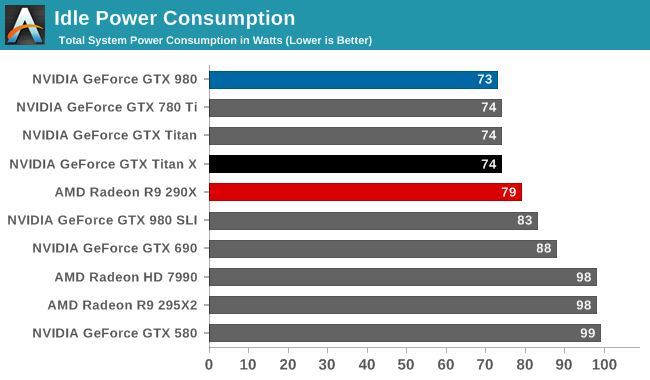
Starting off with idle power consumption, the GTX Titan X comes out strong as expected. Even at 8 billion transistors, NVIDIA is able to keep power consumption at idle very low, with all of our recent single-GPU NVIDIA cards coming in at 73-74W at the wall.
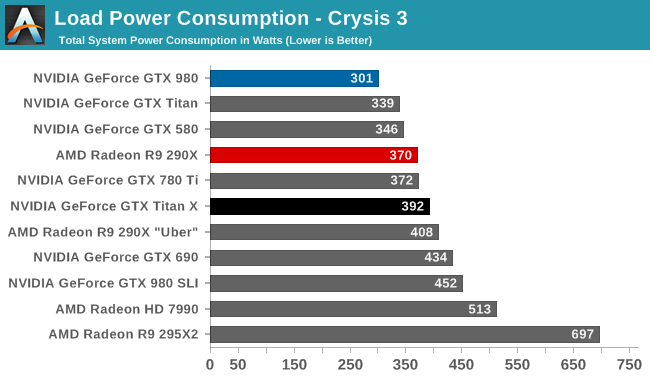
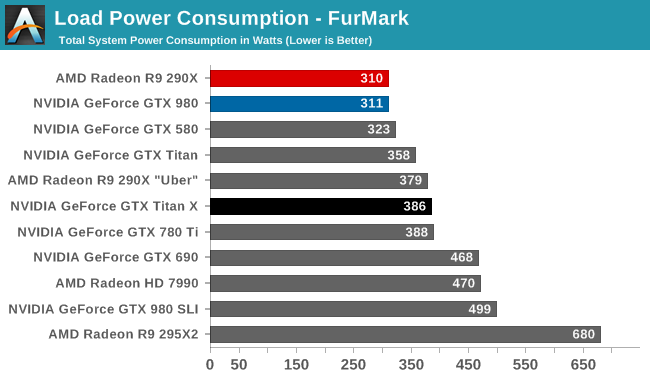
Meanwhile load power consumption for GTX Titan X is more or less exactly what we’d expect. With NVIDIA having nailed down their throttling mechanisms for Kepler and Maxwell, the GTX Titan X has a load power profile almost identical to the GTX 780 Ti, the closest equivalent GK110 card. Under Crysis 3 this manifests itself as a 20W increase in power consumption at the wall – generally attributable to the greater CPU load from GTX Titan X’s better GPU performance – while under FurMark the two cards are within 2W of each other.
Compared to the GTX 980 on the other hand, this is of course a sizable increase in power consumption. With a TDP difference on paper of 85W, the difference at the wall is an almost perfect match. GTX Titan X still offers Maxwell’s overall energy efficiency, delivering greatly superior performance for the power consumption, but this is a 250W card and it shows. Meanwhile the GTX Titan X’s power consumption also ends up being very close to the unrestricted R9 290X Uber, which in light of the Titan’s 44% 4K performance advantage further drives home the point about NVIDIA’s power efficiency lead at this time.
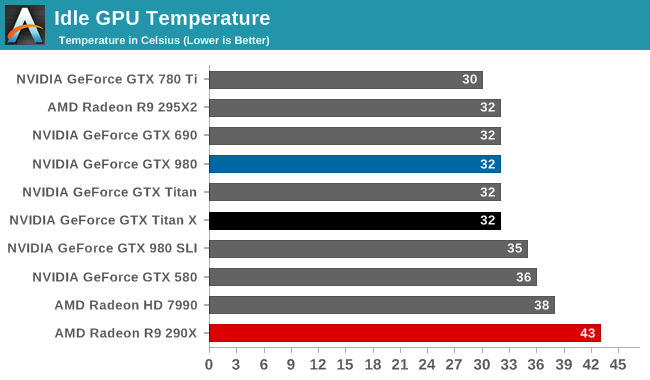
With the same Titan cooler and same idle power consumption, it should come as no surprise that the GTX Titan X offers the same idle temperatures as its GK110 predecessors: a relatively cool 32C.
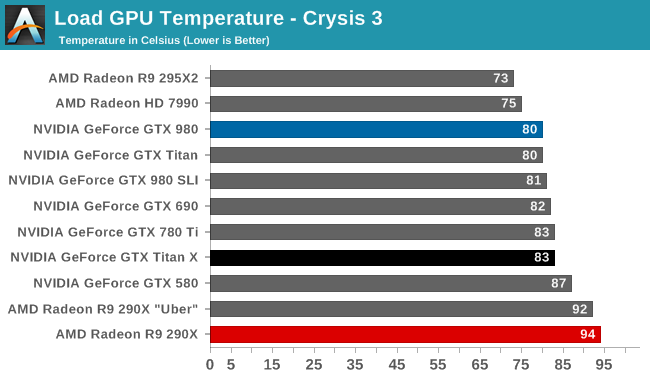

Moving on to load temperatures, the GTX Titan X has a stock temperature limit of 83C, just like the GTX 780 Ti. Consequently this is exactly where we see the card top out at under both FurMark and Crysis 3. 83C does lead to the card temperature throttling in most cases, though as we’ve seen in our look at average clockspeeds it’s generally not a big drop.

Last but not least we have our noise results. With the Titan cooler backing it, the GTX Titan X has no problem keeping quiet at idle. At 37.0db(A) it's technically the quietest card among our entire collection of high-end cards, and from a practical perspective is close to silent.
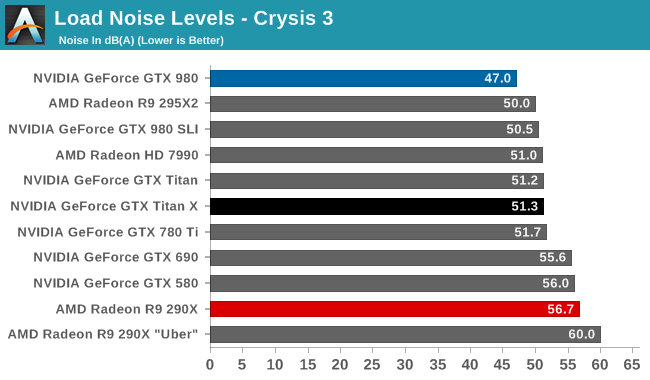
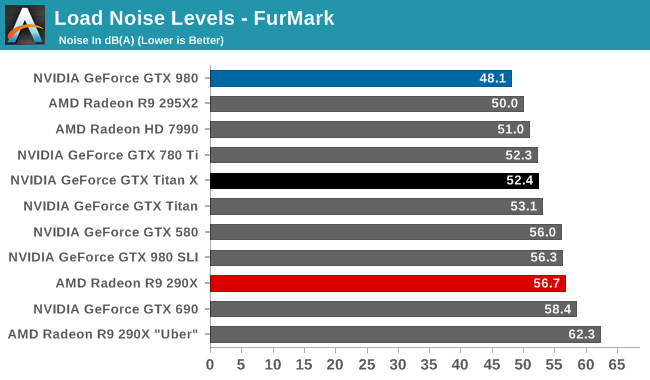
Much like GTX Titan X’s power profile, GTX Titan X’s noise profile almost perfectly mirrors the GTX 780 Ti. With the card hitting 51.3dB(A) under Crysis 3 and 52.4dB(A) under FurMark, it is respectively only 0.4dB and 0.1dB off from the GTX 780 Ti. From a practical perspective what this means is that the GTX Titan X isn’t quite the hushed card that was the GTX 980 – nor with a 250W TDP would we expect it to be – but for its chart-topping gaming performance it delivers some very impressive acoustics. The Titan cooler continues to serve NVIDIA well, allowing them to dissipate 250W in a blower without making a lot of noise in the process.
Overall then, from a power/temp/noise perspective the GTX Titan X is every bit as impressive as the original GTX Titan and its GTX 780 Ti sibling. Thanks to the Maxwell architecture and Titan cooler, NVIDIA has been able to deliver a 50% increase in gaming performance over the GTX 780 Ti without an increase in power consumption or noise, leading to NVIDIA once again delivering a flagship video card that can top the performance charts without unnecessarily sacrificing power consumption or noise.










276 Comments
View All Comments
BurnItDwn - Wednesday, March 18, 2015 - link
So its like 50% faster vs a R9 290, but costs 3x as much ... awesome card, but expensive.uber_national - Thursday, March 19, 2015 - link
I think there's something strange going on in your benchmark if the 7990 is only 3 fps slower than the 295x2 in the 2560x1440 chart...Samus - Thursday, March 19, 2015 - link
"Unlike the GTX 980 then, for this reason NVIDIA is once again back to skipping the backplate, leaving the back side of the card bare just as with the previous GTX Titan cards."Don't you mean "again back to SHIPPING the backplate?"
I'm confused as the article doesn't show any pictures of the back of the card. Does it have a backplate or not?
xchaotic - Thursday, March 19, 2015 - link
Nope. A $999 card and it doesn't have a backplate. This is possibly due to easier cooling in SLI configsAntronman - Thursday, March 19, 2015 - link
It's a blower cooler. So everything goes out the side of the case, which can be desirable if you have cards right on top of each other as the airflow is unobstructed.It's just Nvidia. Unless you need PhysX, you're much better off waiting for the R300s.
Mikmike86 - Thursday, March 19, 2015 - link
Spring pricing is a bit off.R9 290x's go below $300 after rebates quite often now, Febuary I picked up a 290x for about $240 after rebate which was the lowest but have seen several at or below $300 without a rebate.
R9 290s run around $250 and have gone down to $200-$220 recently as a low.
970s have been hovering around $320 but have gone to $290-$300.
Otherwise the Titan X was more for marketing since the 290x (2yr old tech) claws at the 980 at 4k and the 970 falls on it's face at 4k.
This cards a beast don't get me wrong especially when it chases the 295x2 after overclocking, but when you can get a 295x2 for $600 after rebates a couples times a month it just doesn't make sense.
$800 and I could see these selling like hotcakes and they'd still pocket a solid chunk, probably just going to drop a 980ti in a few months after the 390x is released making these 2nd place cards like they did with the og Titans
I go back and forth between Nvidia and AMD but Nvidia has been extra sketchy recently with their drivers and of course the 970.
Refuge - Thursday, March 19, 2015 - link
I just dont' appreciate their price premiums.I've been a fan of Green Team since i was a young boy, but anymore I usually lean Red team.
Just not satisfied with what I'm paying over on the other side to be honest.
Yes when I'm on the Red side I don't always have the same peak performance as Green. But I had enough money afterwards to pay my car payment and take the old lady out to dinner still. ;)
sna1970 - Saturday, March 21, 2015 - link
Nvidia intentionaly made GTX 970 only 4G of ram ... why ? so no one use them in 4K for cheap SLI.I hate nvidia ways.
imagine 3x GTX 970 in SLI for only $900 (300 each)
or 2x GTX 970 , which will be slightly faster than Titan X for $600
but noooooooooo, nvidia will never allow 8G GTX 970 , keep it at 4G so people buy Titan X ...
disgusting . AMD wake up .. we need competition.
medi03 - Thursday, March 26, 2015 - link
There is R9 290x available for nearly half of 980's price, being only 5-15% slower. (and 300w vs 370w total power consumption, I'm sure you can live with it)There is R9 295x2 which handily beats Titan X in all performance benchmarks, with power consumption being the only donwside.
Railgun - Thursday, March 19, 2015 - link
@Ryan Smith. For future reviews, as you briefly touched on it with this one, especially at high resolutions, can you start providing how much VRAM is actually in use with each game? For cards such as this, I'd like to see whether 12GB is actually useful, or pointless at this point. Based on the review and some of the results, it's pointless at the moment, even at 4K.